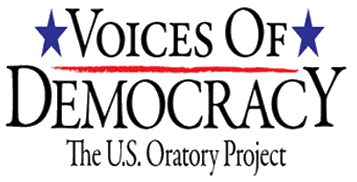GEORGE H.W. BUSH, “SPEECH AT PENN STATE UNIVERSITY” (23 SEPTEMBER 1992)
Classroom Activities
- What were President Bush’s goals in this speech? How did he succeed and/or fail to achieve them?
- Throughout the speech, President Bush frequently uses sports metaphors to convey his personal character and political positions. What are the benefits and consequences of using such metaphors? Are they effective?
- Identify and discuss several ways President Bush attempted to connect with his audience during the speech at Penn State. Do you think these strategies were effective? Why or why not?
- Would President Bush’s campaign speech at Penn State be considered an epideictic speech or a deliberative speech?
- During recent presidential elections, colleges and universities have hosted a number of debates between presidential candidates. Do you believe that debates are more consistent with the educational goals of a university than campaign rallies? Why or why not?
- What do you think should be the policy of colleges and universities toward protests and the display of signs, posters, and banners at campaign rallies or other political events? Should there be any attempt to regulate free speech at all? If you were planning such an event on your campus for the next major presidential campaign, what regulations, if any, would you recommend?
- Do you think it is appropriate to allow VIP sections for supporters of a political candidate during a campaign rally on campus? Is it consistent with the purposes of hosting campaign events on campus?
- A number of PSU alumni wrote angry letters to then-university president Joab Thomas after President Bush’s visit to campus. Many alumni pledged to withhold donations from the university, and some even suggested that they would not allow their children or grandchildren to attend Penn State. Why were these alumni so upset, and do you think their responses were reasonable and justified?
Student Research
- Trace issues of free speech in the United States through the following court cases: Schenck v. United States (1919), Bradenburg v. Ohio (1969), Keyishian v. Board of Regents (1967), Tinker v. Des Moines Independent Community School District (1969), Hazelwood School District v. Kuhlmeier (1988). For each case, summarize the key petitioners, arguments, and the decision. Each of these cases is available through http://www.findlaw.com/
- No campus free speech cases have reached the Supreme Court, but federal district courts have ruled on a variety of cases. Find and read:
- UWM Post v. Board of Regents, 774 F. Supp. 1163 (E.D., Wis. 1991)
- Doe v. The University of Michigan, 721 F. Supp. 852 (E.D., Mich. 1989)
What were the findings in these cases? What Supreme Court cases or constitutional principles did the justices rely on to make their decision?
- Research the 1992 presidential election and explain why you think President Bush’s re-election campaign failed. Do you think President Bush lost his re-election bid for reasons beyond his control? Or do you think his speeches and other attempts to communicate his message contributed significantly to his defeat?
- In the speech to the Economic Club of Detroit and in the speech at Penn State University, President Bush claimed that economic conditions were improving. Did President Bush have good reasons for claiming this? Why do you think the American public did not believe it? How did the Clinton campaign portray economic conditions differently?
- The 1992 presidential campaign has been described as the first presidential campaign in which “new media” played a role. What is meant by “new media,” and what role did “new media” play in the 1992 campaign?
- Watch The War Room, a documentary about the 1992 Clinton campaign. Consider the strategy of the Clinton team versus the apparent strategy of the Bush team, as represented in President Bush’s speech at PSU. Write a paper explaining the differences in strategy, tactics, and policy proposals between the two campaigns.
Citizenship Resources
- What are the free speech policies of your university or college? What sorts of restrictions does your university or college have on protests on campus? Do you feel that these policies are fair and justified? Be prepared to defend your answer. If you disagree with the university or college policies, write an op-ed column for your university or college newspaper advocating a policy change.
- Do you think that colleges and universities should host presidential candidates at all? Why or why not? If you feel that they should host such events, what sorts of policies should they have for political speakers on your campus? Submit this list to your student government or university board of directors. Publicize your proposed standards in your university publication by writing an op-ed and/or news article to your campus or local newspaper.
- Create a free speech event on campus. Pick one or two controversial issues and invite students representing both sides to make statements. Publicize the event throughout your community.
- The Penn State University Blue Band has recently appeared at a variety of events, including the Rose Bowl Parade and Monday Night Football. The band was even featured on the catwalk of the 2005 New York City Fashion Week show and in stories in Vogue and W magazine. Should the Penn State University Blue Band participate in such events? Is their participation in these events different than their participation in political rallies? Investigate the activities of your own school’s band and/or cheer leading squad and draft an op-ed piece expressing your opinion about the proper role of such university-affiliated groups.
- During the next election cycle, work with a campus group to invite a candidate to speak on campus. Consider sponsoring back-to-back events. For local and state races, invite candidates for the same position to engage in a debate on campus.
